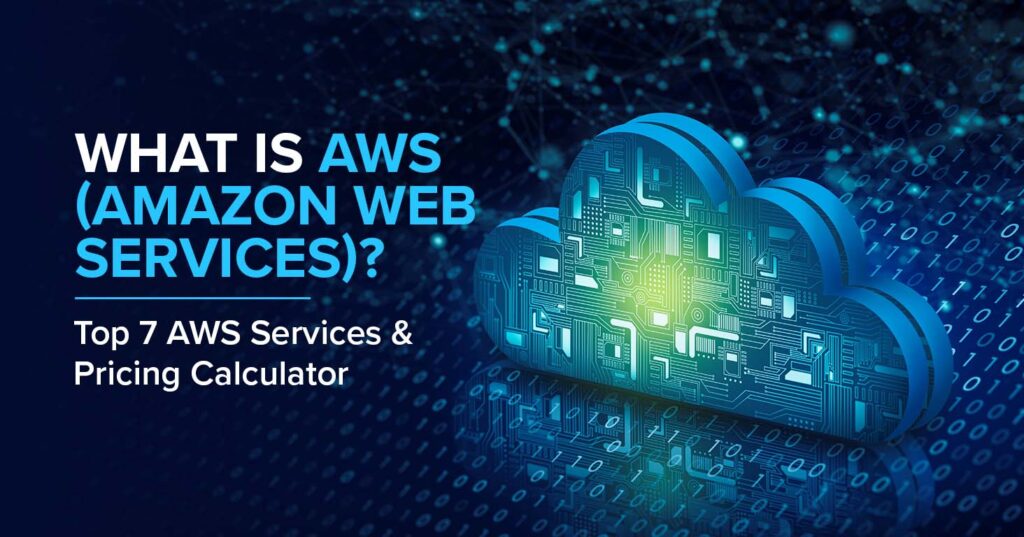What is AWS (Amazon Web Services)? Top 7 AWS Services & Pricing Calculator
14 +
Years of Experience
550 +
Happy Customers
250 +
Years of Tech Leadership Exp.

"License Reseller" and "Consulting & Implementation" Partner

AWS Governance services, such as AWS Organizations and AWS Control Tower, help manage policies, compliance, and multi-account setups.
With services such as EMR or Elastic Map Reduce, AWS has advanced big data tools that can help process and analyse large datasets. Cloud computing has transformed business operations in the digital era by providing businesses with scalable, adaptable, and cost-effective solutions. One of the top cloud service providers is Amazon Web Services (AWS), which is a comprehensive platform that encompasses services required for innovation and scaling for all types of organizations. In this blog post, we will delve deeper into AWS, including its significance, significant services, pros and cons, and how to use AWS Pricing Calculator.
What is AWS?
Amazon Web Services (AWS) is an amalgamation of Infrastructure-as-a-Service (IaaS), Platform-as-a-Service (PaaS), along with Software-as-a-service (SaaS). Established in 2006, AWS allows firms to access computing power storage, among other resources, only when needed without necessitating physical infrastructure. The global presence of this company, which ensures high availability coupled with redundancy, has data centers situated in many regions around the world.

Why is AWS Important?
Scalability, flexibility, and its vast array of available services have made AWS indispensable for modern businesses. It fosters innovation by enabling companies to deploy apps rapidly, scale operations, and try out new technologies without much upfront capital investment. With worldwide infrastructure, AWS guarantees both reliability and performance. Thus, it is one of the common platforms used by enterprises, startups, and government agencies.
Top 7 AWS Services
Though there are more than two hundred services provided by Amazon Web Services, here are the top seven most frequently requested:
1. Amazon EC2 (Elastic Compute Cloud)
Amazon EC2 offers elastic computing capacity within its cloud environment while eliminating any need for upfront hardware costs, allowing faster development and deployment of applications by business owners. Such environments offer scalability or decrease depending on demand, therefore making them more resourceful at minimum expenses.
2. Amazon S3 (Simple Storage Service)
This object storage service provided by Amazon has industry-leading scalability data availability and security. Hence, it is suitable for hosting websites, mobile applications, enterprise backups, restoring big data analytics, IoT devices, etc.
3. Amazon RDS (Relational Database Service)
Amazon RDS is a cloud-based platform that simplifies the setup, operation, and scaling of relational databases. This approach provides economic scaling capabilities and also automates some of the time-consuming administration tasks, namely hardware provisioning, database setup, and patching backups, among others. Amazon Aurora PostgreSQL, MySQL MariaDB, and Oracle Microsoft SQL Server are just a few examples of RDS-supported engines.
4. AWS Lambda
AWS Lambda enables running code without thinking about servers, as there is no need to provision or manage them. You pay only for the actual computing time used with applications automatically scaling via code running on every trigger. It can be used for real-time data processing, such as file transformation and automatic workflows.
5. Amazon CloudFront
Amazon’s CloudFront is a secure content delivery network (CDN) service that distributes data video applications APIs globally through low latency connections at high speeds. It also integrates tightly with other AWS security and performance features.
6. Amazon DynamoDB
It is an advanced, flexible NoSQL database designed for single-digit millisecond performance at any scale; it’s a fully managed multi-region multi-active database with built-in security backup restore and in-memory caching options included.
7. Amazon VPC (Virtual Private Cloud)
Amazon VPC enables you to have a portion of AWS cloud that is logically separated, where you can deploy AWS resources in a virtual network of your choice. You are given full authority over the virtual networking environment, beginning from resource placement connectivity to security.
List of Services in AWS
- Compute: AWS offers several computing services, such as EC2, Lambda, and Elastic Beanstalk, which can support different types of computations ranging from virtual servers to serverless computing.
- Storage: Apart from S3, AWS makes available different storage options, such as Amazon Glacier for storing archives and AWS Storage Gateway for hybrid cloud storage.
- Databases: AWS has a variety of database types ranging from relational (RDS) NoSQL (DynamoDB) to data warehousing (Redshift).
- Infrastructure Management: AWS offers tools like AWS CloudFormation and AWS OpsWorks, which enable users to create resources or manage them via templates and automation.
- Application Development: From coding through deployment, the application development lifecycle is streamlined by services such as AWS CodeBuild, AWS CodeDeploy, and AWS CodePipeline.
- Data Management: AWS has strong data management tools that include ETL processes in the name of AWS Glue, the creation of data lakes using the service called Lake Formation by Aws and querying data using another service called Athena by Amazon.
- Migration: AWS Migration Hub, AWS Server Migration Service, and AWS Database Migration Service allow users to move their applications and databases seamlessly into the cloud.
- Hybrid Cloud: Services like Outposts offered by Aws enable running AWS infrastructure on-premises, thus supporting hybrid cloud environments.
- Networking: Amazon VPC, AWS Direct Connect, and Transit Gateway are examples of the many networking services provided by Aws for connectivity that are secure and can be scaled up easily.
- Development Tools: AWS offers a suite of development tools, including AWS Cloud9, AWS CodeStar, and AWS X-Ray, to enhance productivity and streamline application development.
- Management: Some of these tools include Config from Amazon Web Services (AWS), CloudTrail from AMZN, and Systems Manager, also known as SM.
- Monitoring: Key monitoring solutions accessible within this environment include X-Ray, supplied by Amazon Web Services (AWS); Trusted Advisor by AWS; and CloudWatch, which is synonymous with Amazon Web Services.
- Security: Two of the most popular security services offered by Amazon Web Services (AWS) are Identity and Access Management (IAM) and Key Management Service (KMS).
- Analytics: Services like Kinesis and Glue are some of the analytics options available at AWS for real-time data streaming and visualisation.
- Artificial Intelligence (AI): Users may also access SageMaker, developed by the company specifically for constructing and training machine learning models; Polly, which is a Text-to-Speech product; or Rekognition – an Image and Video Analysis solution, among other AI services.
- Mobile Development: Some examples of these tools are Mobile Hub from AMZN, Cognito, which is provided by Amazon Web Services (AWS), and Amplify, which was created by AWS.
- Messages and Notifications: For example, Simple Notification Service, or SNS, and Simple Queue Service, abbreviated as SQS, have been designed to provide users with strong messaging and notification capabilities.
AWS Benefits and Drawbacks
Benefits:
- Scalability: Resources can easily be scaled up or down based on demand.
- Cost-Effectiveness: The pay-as-you-go model reduces upfront costs.
- Global Reach: Multiple regions’ data centres ensure availability remains high.
- Security: There are many secure features available, along with compliance certifications.
- Innovation: Rapid deployment and experimentation with new technologies.
Drawbacks:
- Complexity: For beginners, many services might overwhelm them when they get started.
- Cost Management: If resources aren’t monitored, there could be unforeseen expenses.
- Dependence: Relying on AWS infrastructure means one may become locked into this environment.
- Downtime: Although unlikely, AWS service outages can impact business operations.
AWS Pricing and Pricing Calculator
Amazon Web Services operates on a pay-as-you-go pricing model, which can be customized in a variety of ways, such as reserved instances for longer-running workloads or volume-based discounts for larger customers. The AWS Pricing Calculator lets users enter details about any service they intend to use and then computes an estimate based on these inputs. It indicates how much it will cost to utilize every required computing, storage, data transfer, and other resources needed by the user. The top AWS pricing models are as follows:
Pay-As-You-Go (On-Demand)
- Best For: Immediate, unpredictable workloads.
- Cost: No upfront payments with real-time billing for every consumed service.
Reserved Instances (RI)
- Cost: Up to 75% discounts for a 1 or 3 year agreement.
- Best For: Predictable and stable workloads.
Savings Plans
- Cost: Save up to 72% by committing to consistent usage levels.
- Best For: Highly customisable multi-service wide applications.
Spot Instances
- Cost: Unused capacity can save you up to 90%.
- Best For: Workloads that are both variable and can be interrupted at any time.
Dedicated Hosts and Instances
- Best For: Compliance needs and predictable performance requirements.
- Cost: Full control of physical servers.
Free Tier:
- Best For Exploring AWS services without spending much money on them in the beginning.
- Cost: Free up to some limits for new users only.
Sample AWS Service Costs
- Amazon EC2: $0.09 per GB for the first 10 TB/month.
- Amazon S3: $0.023 per GB for the first 50 TB/month.
- Amazon Aurora: $0.10 per GB/month for storage.
- Amazon RDS: $0.016 per hour for standard instances.
- Amazon DynamoDB: $0.02 per 100,000 read operations.
- Amazon CloudFront: $0.085 per TB for the first 10 TB.
- Amazon VPC: Free (charges for optional features).
- Amazon Kinesis: $0.04 per data stream per hour.
- Amazon SageMaker: $0.05 per hour for standard configurations.
From pay-as-you-go to long-term commitments, AWS offers different pricing options that cater to varying needs and budgets, facilitating flexible and cost-effective management of cloud resources. Additionally, the AWS Pricing Calculator simplifies forecasting and budgeting for AWS services.
Why Choose DevTools as Your Trusted Partner
Selecting a partner for your cloud journey is a critical decision. What makes DevTools different? The first point of distinction between us and other providers is our expertise and experience.
Our team has a wide range of experts who are well-versed in deploying, designing, and handling AWS solutions on diverse client bases. We follow the latest service trends of Amazon Web Services (AWS) as well as their best practices, resulting in satisfactory outcomes.
Broad Range of Offerings
Starting from exhaustive audits and premeditated strategies to hassle-free transitions and constant enhancements, we cater for every requirement regarding migrating into the cloud. Also, we have hypercare deals that guarantee efficient provisioning, monitoring and maintenance of your AWS infrastructure.
Customizable Assistance
We offer ‘customer-oriented’ solutions within our AWS support options, which will match your specific business objectives or financial capabilities. By doing so, we ensure that the security, optimisation and reliability features of your cloud environment are constantly upheld.
Minimizing Costs
Our team of professionals assists you in cutting down on Amazon Web Services expenses by identifying areas with potential savings opportunities, such as downsizing or rightsizing resources, and considering cost-effective architectural designs. We also guide you on how to calculate cost based on Amazon pricing models among reservation instances as some techniques to help reduce the budget.
Choose DevTools for an easy-to-use, dependable, yet affordable route into AWS’s cloud. Call us today to arrange a meeting with one of our AWS consultants so that you can benefit from it.
Conclusion
Amazon Web Services (AWS) is a dominant cloud platform offering a wide range of functions depending on the business’s requirements. It is the preferred service provider globally due to its flexibility, scalability, and comprehensive approach. Knowing about AWS’s most popular services and employing tools such as the AWS Pricing Calculator helps companies govern their cloud infrastructure while cutting down on costs. Therefore, companies are leading in innovation and advancement in today’s competitive business landscape.




